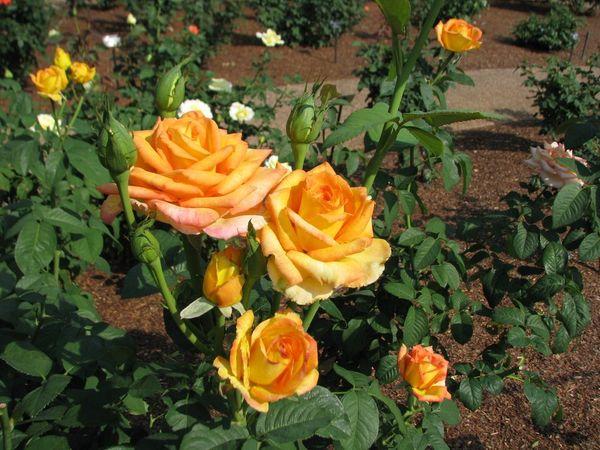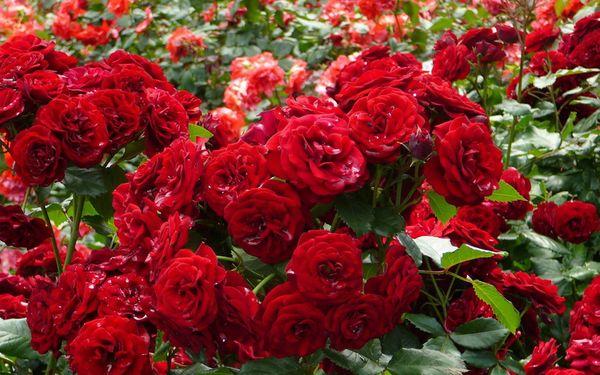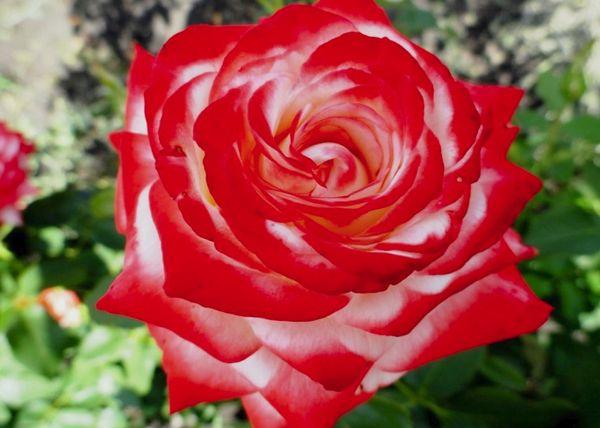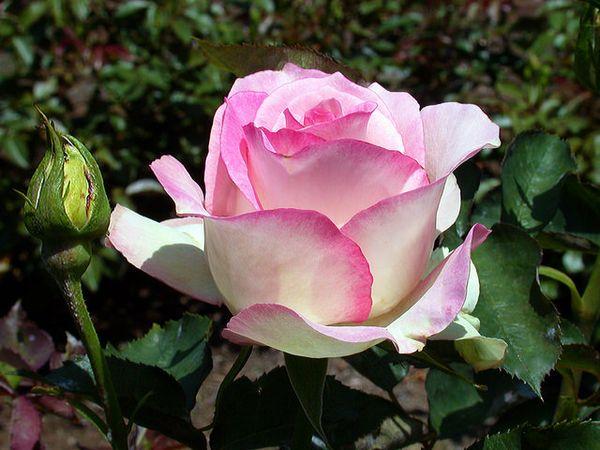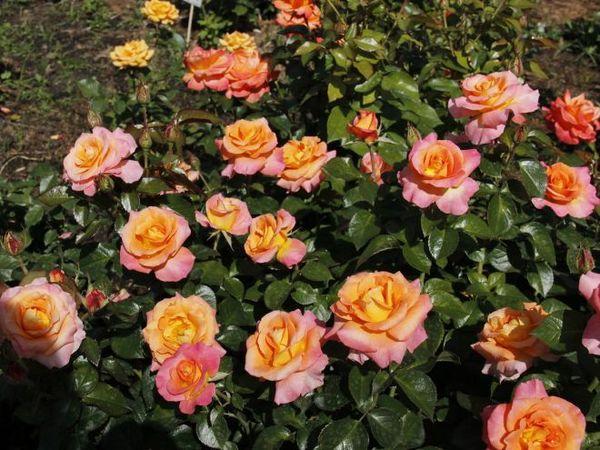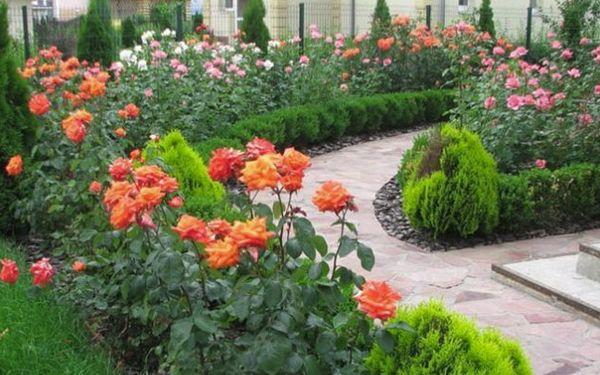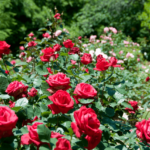Hybrid tea varieties of roses are a common type of crop for garden decoration. When choosing a crop, gardeners have a variety of varieties that differ not only in the color of the buds, but also in the smell. Plants allow you to create arrangements or use flowers to create bouquets.
- Main features of hybrid tea roses
- Plant varieties
- Popular varieties
- High
- Medium height
- White and yellow
- Pink and red
- Growing conditions
- Landing Features
- Specifics of flower care
- Hilling
- Bloom
- Watering
- Trimming
- Top dressing
- Pests and diseases of hybrid tea roses
- Breeding methods
- Use in landscape design
- Possible problems
Main features of hybrid tea roses
Plants can be used to decorate flower beds or as bouquets. The type of rose was formed as a result of crossing tea and remontant flowers. The flowers have a dense bud structure and open slowly, which allows the buds to retain their attractive aroma and remain in the flowering process for a long time. The bushes are easy to shape into the desired shape and, as a rule, have dark leaves with a red tint.
Plant varieties
Plants differ not only in the color of the buds, but also in the height of the bush. There is a list of varieties that are most often used to decorate flower beds and front gardens.
Popular varieties
It is necessary to note the most common varieties:
| Variety | Description |
| American pride | Bushes up to 80 cm are distinguished by the richness of the color of the bud, which has a dark red tint. Flowers can be single type and with a large number of inflorescences, have a weak odor, but the flowering period of the bud is 7-10 days |
| Alexander | A plant with large velvety buds of bright red color. The plant blooms for a long period, the height of the bush reaches one meter |
| Princess Alexandra | The bushes have spreading shoots and reach a height of one meter. Inflorescences up to 10 cm in diameter |
| Di Welt | The bushes bloom profusely throughout the summer. The flowers have a small diameter, yellow buds with pink inner petals |
| Mainzer Fastnacht | The bushes are short in height and have spreading shoots. A distinctive feature is the lilac color of the buds and their diameter up to 10 cm |
The hybrid tea type of roses includes various species; each gardener chooses flowers depending on his preferences.
High
Plants are often used to form bouquets.Common varieties of tall plants include:
- Red Velvet - the height of the crop reaches 1.5 meters. A plant with red buds, which are distinguished by their large diameter and glass shape.
- Rose Gozhar - the height of the bush is 1.3 meters. The buds are red with a white base. Most often, one bud grows on one shoot.
- Texas apricot - the rose got its name due to the color of the bud, which has an apricot color and terry texture. The height of the bush reaches up to 1.5 meters.
Often tall plants are used as a background for flower beds.
Medium height
These types of roses are often grown for cutting and have an attractive appearance that will decorate any garden plot or rose garden. Tall bushes include:
- Virginia - the bush can reach up to 1 meter. At the same time, the shoot grows by 60-70 cm. The buds have the shape of a glass and are distinguished by a large number of petals.
- Eiffel Tower - distinguished by the shape of the inflorescence, which has an elongated, pointed shape. Bushes reach up to 1 meter in height.
- Sphinx Gold - stem height reaches up to 1 meter. The flowers are orange with yellow streaks, the buds are medium in size, the flowers are suitable for cutting. A distinctive feature that distinguishes this variety is the absence of thorns.
- Ambianz - the plant has strong immunity and endures a recovery period after winter. Large buds of peach color. The height of the bush can reach over 1 meter.
With proper care, the bushes bloom all summer until the first frost.
White and yellow
Certain color palettes of roses are often used to design a garden plot. White and yellow colors look good in the composition. These types of flowers include:
- Anastasia - 1 meter tall, pale white inflorescences with a delicate scent.
- Anna - the plant reaches a height of up to 80 cm. The inflorescences are white with a pink border.
- Tequila Sunrise - the culture is distinguished by its bright yellow bud color. Bush height 80 cm.
- Landora - the rose has large inflorescences that reach a diameter of 10 cm. The plants bloom in bright yellow and have a honey smell.
These varieties are suitable for cultivation in all regions and tolerate winter and diseases well.
Pink and red
The varieties have a rich color and pleasant aroma. There are a large number of varieties with this color. However, it is necessary to highlight:
- Lancoma - the plant reaches a height of one meter, the flowers are pale pink, the diameter of the bud is 8-10 cm.
- Vien Rose - the bush has a tall growth that can reach 1.7 meters. Pink buds up to 12 cm in diameter.
- Corvette is a bush up to 1 meter high, the flowers are glass-shaped and bright red.
These varieties have slightly spreading shoots and high resistance to diseases and low temperatures.
Growing conditions
The method of growing the crop depends on the region in which the bushes are used; growing in rose gardens can be used as a material for forming bouquets. Plants can also be used to decorate flower beds and placed in open ground.
Growing conditions are no different from other varieties. The plant requires regular pruning and fertilization. The culture blooms throughout the summer until the first frost. In winter, the shrub must be carefully insulated to reduce the risk of root damage.
Landing Features
In order for the crop to develop better, it is recommended to plant in the spring. Features of planting are as follows:
- the plant is planted in the ground in early May;
- the soil is selected with neutral acidity;
- The landing site should be moderately sunny;
- The landing site must be on level ground; places where melt water accumulates are not used for planting;
- to plant planting material, it is necessary to prepare a hole 30 cm deep and 40 cm wide;
- mix soil with humus;
- the roots of the rose are soaked in the slurry (clay and manure in equal proportions);
- place the seedling in the ground and straighten the roots;
- Sprinkle with soil and tamp down a little.
The grafting site must be immersed in the soil by at least 7 cm.
Important. In order for the plant to quickly adapt to a new place of growth, it is necessary to place the seedlings in water for several hours before planting.
Specifics of flower care
In order for them to delight with abundant flowering, it is necessary to properly care for the crops.
Hilling
It is produced so that the plant forms a bush and does not grow large. This method allows you to increase flowering and strengthen the roots; for hilling, you need to form a mound around the bush and hill up the shoots. This method has a positive effect on the plant and increases the size of the buds.
Bloom
During the flowering period, it is necessary to carefully monitor and promptly remove faded shoots; in the summer, after all the buds have faded, it is necessary to prune the upper shoots into 2 buds. Shoots that do not form buds are also removed.
Watering
The culture does not like moisture, watering is done rarely, but with the use of liquid in large quantities. After planting in open ground, it is necessary to irrigate the plant every 3 days. Later, when the plant begins to form inflorescences, watering is carried out once every 5 days, while at least 10 liters of water should be used per bush.
Important.To ensure that the roots are not damaged during moistening, it is necessary to pour the liquid in a thin stream into the soil.
Trimming
The rose bush requires regular pruning, which is done according to the following scheme:
- the first pruning is carried out in the first year, while the plant is shortened by several buds;
- in the fall of the first year, all flowering shoots are cut off;
- in the spring of the second year it is necessary to circumcise, leaving no more than 4 buds;
- in the fall, all damaged shoots are removed, the plant is pruned into 6-7 buds for further cover.
Pruning hybrid tea roses for the winter produced at the end of September before the onset of the first frosts.
Top dressing
For flowering, it is necessary to monitor the condition of the soil and promptly apply all the necessary bait.
Feeding can be done according to the following principle:
- In spring, before buds form, organic fertilizer is used;
- in the fall of the first year, it is necessary to prepare the plant for winter and spray it with potassium sulfate (2 spoons per 8 liters of water);
- in the second year in the spring, a urea solution is used, which is applied after pruning;
- in mid-May, a mullein solution is used (one kilogram per bucket of water);
- in mid-summer it is recommended to use an infusion of chicken manure;
- in September, wood ash is used as root nutrition and humus.
If a gardener notices symptoms of a lack of useful components, it is necessary to use mineral fertilizers.
Pests and diseases of hybrid tea roses
Roses are immune, especially if hybrid tea varieties were purchased at specialized sales outlets. With improper care, the following diseases can occur:
- Powdery mildew - manifests itself as a white coating on the leaves; damaged leaves and shoots must be removed.
- Gray rot - damages buds and buds. Damaged areas must be removed and the plant must be sprayed with horsetail decoction.
- Sooty plaque - occurs as a result of the formation of a sticky coating on shoots and leaves, and is removed with a soap solution.
Pests that appear on roses include:
- Aphids - feed on young shoots and leaves, causing the bush to dry out. To eliminate insects, spray with a soap solution.
- Leaf rollers - attack the leaves of the plant and cause them to turn yellow. To eliminate it, special insecticides are used.
To reduce the likelihood of pests in the fall, it is necessary to remove fallen leaves and sprinkle the soil with wood ash.
Breeding methods
Hybrid tea roses are decorative flowers that are suitable for planting in central Russia. You can purchase crops or prepare planting material yourself. Roses reproduce as follows:
- Cuttings - for this, stems with faded buds are taken, cut into cuttings up to 10 cm long. The cuttings are placed in a growth activator for an hour, after which they are planted in the soil and covered with glass jars on top. Next spring, the plant can be transplanted to another place of growth.
- Vaccination. For this method of propagation, it is necessary to cut off a bud from the shoot and graft it onto a rose hip; for grafting, an incision is made into which the bud is inserted and wrapped with plastic tape. The vaccination is left until next spring.
Roses can spread from the mother bush. To do this, the shoot bends towards the ground and an incision is made.The cut site is covered with earth and watered regularly until a new shoot appears.
Use in landscape design
Rose varieties can be combined with other plants. Plants are not picky about their surroundings, they can be used as decoration for front gardens and can be used both for individual decoration and compositions.
Possible problems
Proper crop care can reduce the formation of problems during the growing period, which include:
- No drainage. Such plants quickly become susceptible to diseases, as liquid stagnates, which causes rotting.
- Plants must be covered for the winter. Despite the fact that the varieties are resistant to low temperatures, covering the roots is mandatory.
- The culture does not develop and blooms poorly. It is necessary to apply mineral fertilizers.
- After planting, the bush gets sick. It is necessary to purchase seedlings only from trusted places. Good planting material is the key to success in growing crops.
When preparing material, it is necessary to treat the cuttings with a growth activator.
A rose is a decoration for any garden. A correctly selected variety will delight others with abundant flowering for a long time. Common types of culture are hybrids of tea roses, which do not require care and easily adapt to a new place of growth.

